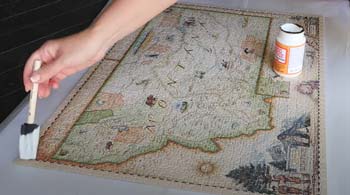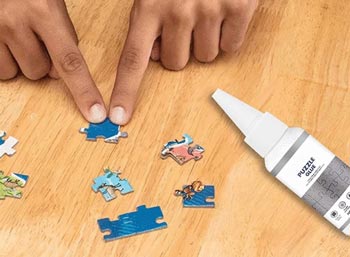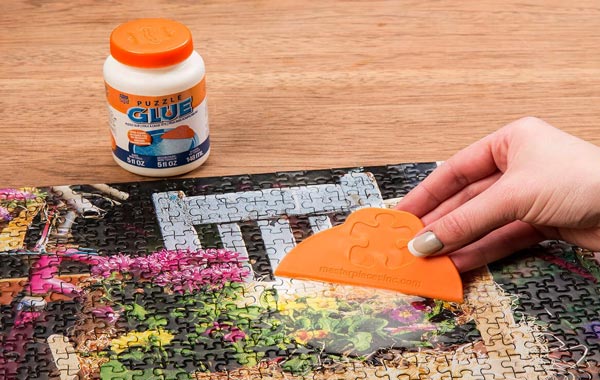How To Glue A Puzzle? Step-By-Step Guide with Video
So you have completed a very complicated set of jigsaw puzzles, and now want to keep it intact for a long time. But how to glue a puzzle? A Step by step process needs to be followed for successful results.
Luckily, the process is not too hard to follow. But, there are a few things that you need to keep in mind before you leather on the puzzle pieces with glue.
Different jigsaw puzzles are made with different types of material. So, you need to use glue based on the material.
The process that you need to follow might also need to be adjusted depending on the type of material you are working with.
But, don't worry, we have got all that you need to know covered in this article.
Table of Contents
Why Do People Glue Puzzles?
The main reason people glue their puzzles is to preserve them.
A lot of jigsaw puzzles, come with 100, to even 1,000 pieces. It can take a lot of time to complete these puzzles.
When someone has successfully completed a puzzle, they might want to cherish the memory forever.
That is why, people use different kinds of puzzles and craft glues to set the puzzles in place permanently. These glues can also add a very nice glossy finish to the puzzle. People frame these puzzles to preserve the experience and cherish it for life.
How To Glue A Puzzle? Easy Method Explained

Before you get started on gluing your puzzle, let's take a look at a shortlist of the materials that you might need.
- Wax Paper
- Rolling Pin
- Paint Brush Or Sponge
- Measuring Tape
- Glue Such As Mod Podge Or Craft Glue
- Cardboard
- Frame
Now let's get into the gluing process.
Step 1: Cut The Wax Paper
The first thing that you need to do is get some wax paper. If you don't have wax paper, you can also use parchment paper that is used for baking.
Measure out the finished puzzle on the paper, and cut the paper a bit larger than this size. Cut the paper about one or two inches larger than the finished puzzle size.
Place this paper on a smooth and flat surface.
Step 2: Flatten The Puzzle Pieces
Next, you will place the puzzle on top of the wax or parchment paper. The puzzles need to face up on the paper.
Then, use your rolling pin to flatten out the puzzle pieces.
Do not apply too much pressure. If you feel too much resistance when rolling the pin on the puzzle, back off, and take a look at the puzzle pieces again. One or two pieces might be out of place. Adjust the pieces as required, and continue flattening them out with the rolling pin.
Step 3: Add The Glue
Now comes the fun part, it's time to add on the glue. Before slathering on the glue, make sure you have selected glue that is meant to work with puzzle pieces.
Mod podge or craft glue might be a good option. Different types of glues have different directions. Read the label carefully to get to know about these directions properly.
But, in general, you have to apply the glue in very thin layers. You can use a painting brush, or even a sponge to do this process.
Make sure that the glue is applied in an even thickness across the puzzle.
Step 4: Let The Glue Dry
Now, you have to wait for the glue to dry completely. How long the glue will take to dry depends on the brand you are using.
While the glue might seem to have completely dried within 3 hours of application, we recommend waiting for at least 24 hours to let the glue cure completely.
Step 5: Frame
Most people will glue their puzzles just so they can frame them.
Before you frame the puzzle, you need to make sure that the puzzle has dried completely. There should be no tacky glue on the surface.
Peel the parchment or wax paper off of the puzzle. If the glue has dried completely, the puzzle should come off nice and easy.
To give the puzzle some more support, you should add a piece of cardboard behind the puzzle.
Choose any frame of your liking that will be able to fit the puzzle, and frame it as you wish.
Tips And Tricks On How to Glue and Display A Finished Puzzle

Gluing puzzles can seem like a very easy task until you mess it up. Here are some tips and tricks that you can follow to avoid any mishaps.
1. Use Puzzle Safe Glue
When gluing a puzzle, you should only use glue that is meant for attaching puzzle pieces.
A lot of times, blue pieces are made with cardboard. Glues that are meant to be used on wood, or plastic, might have harsh chemicals that can eat into the cardboard and destroy the puzzle piece.
Avoid this. You should only use craft glue or mod podge. There are special types of glues available for attaching puzzle pieces. You can use those too.
2. Do Not Apply Too Much Pressure
When you are using the rolling pin to flatten out the puzzle pieces, try not to use excessive pressure.
As we have mentioned before, the puzzle pieces need to be flattened out very carefully. If you feel too much resistance when using the rolling pin, you should stop.
Take a break, and check whether all of the puzzle pieces are in the correct position. The resistance might be caused by puzzle pieces that have not been correctly placed.
3. Avoid Adding Too Much Glue
An additional step that some people follow when gluing puzzle pieces, is gluing the backside as well.
This might seem like a good option to keep the puzzle steady, but in reality, adding too much glue can cause the puzzle to curl up.
Once a puzzle has curled up, flattening it out can be a bit difficult. Most of the time, the excessive glue dries and becomes very hard. So when you use a rolling pin to flatten out the puzzle, it cracks and shatters into pieces. These broken pieces are hard to glue back together because they break into uneven pieces.
The excessive glue attached to the parts makes it even harder to glue the entire puzzle back together.
4. Choose A Suitable Frame
Puzzle pieces are made with cardboard and can be a bit thick. That is why you should select a frame that has at least half an inch of space between the glass and the framing cardboard.
This way, the puzzle does not get pressurized or squeezed together.
Conclusion
People have been gluing their puzzle pieces for ages now. It is a very efficient and effective way to preserve this artwork.
Although it was a bit difficult to glue puzzle pieces together in the past, people have come up with better kinds of glues to make the experience a lot easier.
So if you are wondering how to glue a puzzle, don't worry, the process is very simple. Just use the right kind of glue and the right frame, and you'll be good to go!
Up Next: Get a good quality glue for miniatures from our lists.

